初中英语中考专题复习:简单句
- 格式:ppt
- 大小:1.23 MB
- 文档页数:7

初中英语“简单句”专题讲解(一)基本概念只包含一个主语(或并列主语)和一个谓语(或并列谓语)的句子,称作简单句。
在简单句中主语和谓语是句子的主干,是句子的核心。
除了主语和谓语外,简单句中还可以有宾语、表语、补语、状语、定语等。
(二)句型结构简单句可归纳为五个基本句型。
1.主语+谓语这种句型简称为主谓结构,其谓语一般都是不及物动词,后面可以有其他成分修饰。
如:T h i n g s c h a n g e.H e s m i l e s h a p p i l y.2.主语+连系动词+表语这种句型称为主系表结构。
如:M r.S m i t h i s a n a r t i s t.T h e h a m b u r g e r t a s t e s g o o d.注:表语位于系动词之后。
常由名词、形容词、副词、介词短语、不定式、动词的-i n g、从句来充当。
常见系动词有:(1)表状态系动词---b e如:H e i s a t e a c h e r.H e i s i l l.(2)持续系动词--用来表示主语继续或保持一种状况或态度,常见有k e e p,r e m a i n,s t a y,如:H e a l w a y s k e p t s i l e n t。
(3)表像系动词--用来表示"看起来像"这一概念,主要有s e e m, a p p e a r,l o o k,如:H e l o o k s t i r e d.H e s e e m s(t o b e)v e r y s a d.(4)感官系动词---感官系动词主要有f e e l,s m e l l,s o u n d, t a s t e,如:T h i s k i n d o f c l o t h f e e l s v e r y s o f t.。
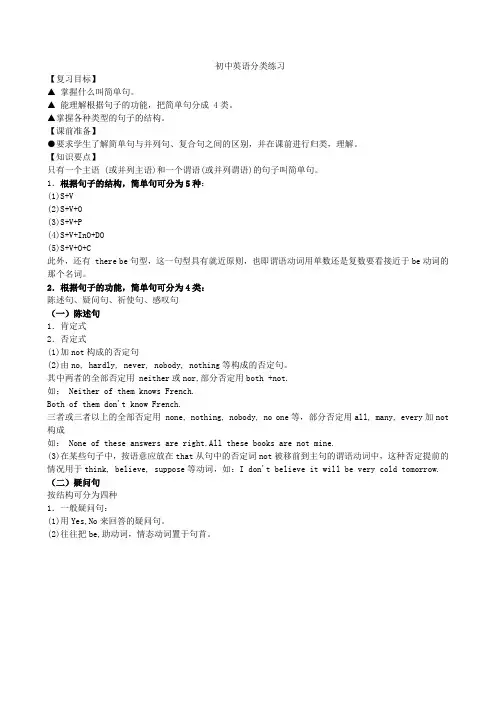
初中英语分类练习【复习目标】▲ 掌握什么叫简单句。
▲ 能理解根据句子的功能,把简单句分成 4类。
▲掌握各种类型的句子的结构。
【课前准备】●要求学生了解简单句与并列句、复合句之间的区别,并在课前进行归类,理解。
【知识要点】只有一个主语 (或并列主语)和一个谓语(或并列谓语)的句子叫简单句。
1.根据句子的结构,简单句可分为5种:(1)S+V(2)S+V+O(3)S+V+P(4)S+V+InO+DO(5)S+V+O+C此外,还有 there be句型,这一句型具有就近原则,也即谓语动词用单数还是复数要看接近于be动词的那个名词。
2.根据句子的功能,简单句可分为4类:陈述句、疑问句、祈使句、感叹句(一)陈述句1.肯定式2.否定式(1)加not构成的否定句(2)由no, hardly, never, nobody, nothing等构成的否定句。
其中两者的全部否定用 neither或nor,部分否定用both +not.如: Neither of them knows French.Both of them don't know French.三者或三者以上的全部否定用 none, nothing, nobody, no one等,部分否定用all, many, every加not 构成如: None of these answers are right.All these books are not mine.(3)在某些句子中,按语意应放在that从句中的否定词not被移前到主句的谓语动词中,这种否定提前的情况用于think, believe, suppose等动词,如:I don't believe it will be very cold tomorrow. (二)疑问句按结构可分为四种1.一般疑问句:(1)用Yes,No来回答的疑问句。
(2)往往把be,助动词,情态动词置于句首。
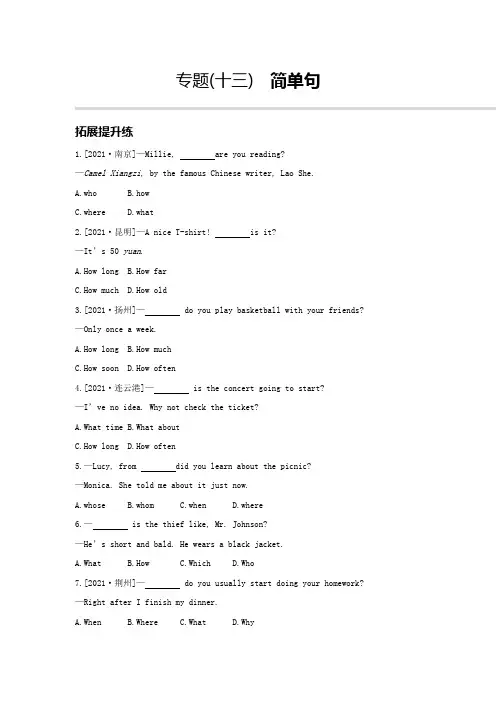
专题(十三) 简单句拓展提升练1.[2021·南京]—Millie, are you reading?—Camel Xiangzi, by the famous Chinese writer, Lao She.A.whoB.howC.whereD.what2.[2021·昆明]—A nice T-shirt! is it?—It’s 50 yuan.A.How longB.How farC.How muchD.How old3.[2021·扬州]— do you play basketball with your friends? —Only once a week.A.How longB.How muchC.How soonD.How often4.[2021·连云港]— is the concert going to start?—I’ve no idea. Why not check the ticket?A.What timeB.What aboutC.How longD.How often5.—Lucy, from did you learn about the picnic?—Monica. She told me about it just now.A.whoseB.whomC.whenD.where6.— is the thief like, Mr. Johnson?—He’s short and bald. He wears a black jacket.A.WhatB.HowC.WhichD.Who7.[2021·荆州]— do you usually start doing your homework? —Right after I finish my dinner.A.WhenB.WhereC.WhatD.Why8.[2021·绥化改编]There is plenty of information about AI(人工智能) on the website, ?A.isn’t thereB.isn’t itC.is thereD.is it9.[2021·龙东改编]—It is rude to ask direct questions, ?—Yes, but I think it’s OK to your close friends.A.isn’t itB.doesn’t itC.does itD.is it10.—He’s never been asked to work hard, ?—. His teachers always encourage him.A.is he; No, he isn’tB.has he; No, he hasn’tC.has he; Yes, he hasD.is he; Yes, he is11.[2021·云南]—Our class won the first prize in today’s basketball match. — exciting news it is! We’re all glad about it.A.WhatB.What anC.HowD.How an12.[2021·武威]—They’ve bought the sick children some toys and flowers.—So they have. nice of them!A.HowB.WhatC.How aD.What a13.[2021·遂宁]—He has made many friends since he came here three weeks ago. — outgoing boy he is!A.How aB.HowC.What aD.What an14.[2021·宿迁]— nice music lesson Mrs Wu gave us today!—Yes. We enjoyed it very much.A.WhatB.What aC.HowD.How a15.If you’re interested in our business plan, this number and ask for Ms Lee. She’ll answer your questions.A.callingB.callC.and callD.to call16.[2021·绥化改编] it over, and you will be able to work out the problem.A.ThinkingB.To thinkC.ThinkD.Thought17.[2021·梧州]— your hands before dinner, Tony.—No problem, Mom.A.WashB.WashesC.WashingD.To wash18.[2021·襄阳]— nice weather it is to go hiking! Would you like to go with me?—Good idea! Let’s go.A.How aB.HowC.What aD.What19.[2021·大连] at people when you talk. This is a polite way of communication in China.A.LookB.LookingC.To lookD.Looked20.— fast China is developing!—Yes. We are so lucky to live in such a great country!A.WhatB.What aC.HowD.How a21.[2021·郴州改编]—Could you please tell me the library is from here? —It’s about fifteen minutes’ ride.A.how soonB.how longC.how farD.how often22.[2021·滨州]— do you think we can finish the report?—Perhaps in one more hour.A.How longB.How muchC.How soonD.How often23. quiet and sit down. The teacher will tell us some important news.A.KeptB.To keepC.KeepingD.Keep24.[2021·绥化改编]Only at that time that he was wrong.A.he realizedB.did he realizeC.he did realizeD.can he realize25.[2021·恩施州改编]—I have never been to Tenglong Cave.—.A.Neither do IB.So have IC.Neither have ID.So do I26.—Is he speaking Spanish? I can hardly catch a word.—. He’s from Brazil, so I guess maybe it is Portuguese(葡萄牙语). A.So I can B.Neither can IC.Neither I canD.So can I【参考答案】拓展提升练1.D2.C 考查疑问词辨析。
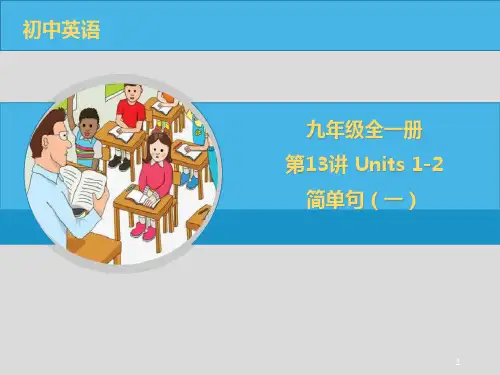


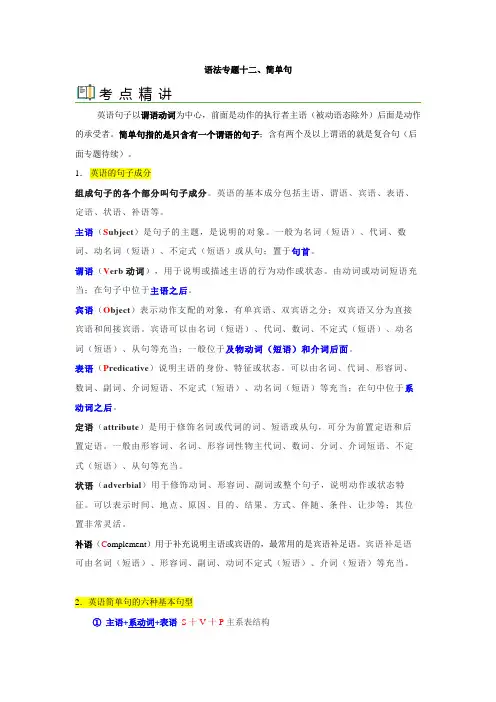
语法专题十二、简单句考点精讲英语句子以谓语动词为中心,前面是动作的执行者主语(被动语态除外)后面是动作的承受者。
简单句指的是只含有一个谓语的句子;含有两个及以上谓语的就是复合句(后面专题待续)。
1.英语的句子成分组成句子的各个部分叫句子成分。
英语的基本成分包括主语、谓语、宾语、表语、定语、状语、补语等。
主语(S ubject)是句子的主题,是说明的对象。
一般为名词(短语)、代词、数词、动名词(短语)、不定式(短语)或从句;置于句首。
谓语(V erb动词),用于说明或描述主语的行为动作或状态。
由动词或动词短语充当;在句子中位于主语之后。
宾语(O bject)表示动作支配的对象,有单宾语、双宾语之分;双宾语又分为直接宾语和间接宾语。
宾语可以由名词(短语)、代词、数词、不定式(短语)、动名词(短语)、从句等充当;一般位于及物动词(短语)和介词后面。
表语(P redicative)说明主语的身份、特征或状态。
可以由名词、代词、形容词、数词、副词、介词短语、不定式(短语)、动名词(短语)等充当;在句中位于系动词之后。
定语(attribute)是用于修饰名词或代词的词、短语或从句,可分为前置定语和后置定语。
一般由形容词、名词、形容词性物主代词、数词、分词、介词短语、不定式(短语)、从句等充当。
状语(adverbial)用于修饰动词、形容词、副词或整个句子,说明动作或状态特征。
可以表示时间、地点、原因、目的、结果、方式、伴随、条件、让步等;其位置非常灵活。
补语(C omplement)用于补充说明主语或宾语的,最常用的是宾语补足语。
宾语补足语可由名词(短语)、形容词、副词、动词不定式(短语)、介词(短语)等充当。
2.英语简单句的六种基本句型①主语+系动词+表语S十V十P主系表结构➢English is very easy. 英语很容易。
(be动词)➢It smells delicious. 它闻起来好香。
(感官动词,smell, taste, look, sound, feel)➢The food has gone bad.食物已经变质了。
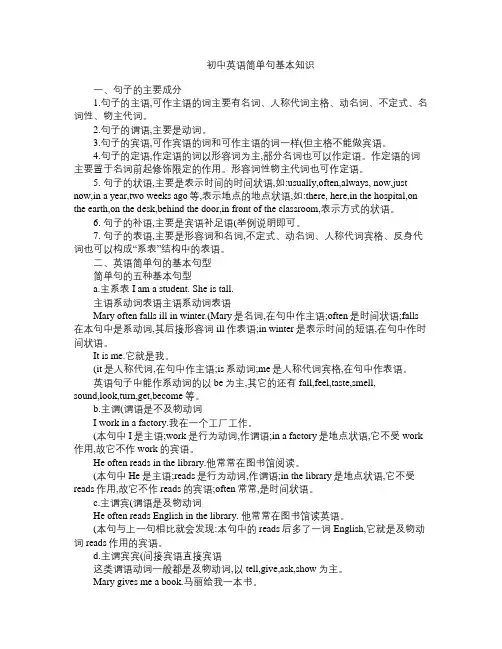
初中英语简单句基本知识一、句子的主要成分1.句子的主语,可作主语的词主要有名词、人称代词主格、动名词、不定式、名词性、物主代词。
2.句子的谓语,主要是动词。
3.句子的宾语,可作宾语的词和可作主语的词一样(但主格不能做宾语。
4.句子的定语,作定语的词以形容词为主,部分名词也可以作定语。
作定语的词主要置于名词前起修饰限定的作用。
形容词性物主代词也可作定语。
5. 句子的状语,主要是表示时间的时间状语,如:usually,often,always, now,just now,in a year,two weeks ago等,表示地点的地点状语,如:there, here,in the hospital,on the earth,on the desk,behind the door,in front of the classroom,表示方式的状语。
6. 句子的补语,主要是宾语补足语(举例说明即可。
7. 句子的表语,主要是形容词和名词,不定式、动名词、人称代词宾格、反身代词也可以构成“系表”结构中的表语。
二、英语简单句的基本句型简单句的五种基本句型a.主系表I am a student. She is tall.主语系动词表语主语系动词表语Mary often falls ill in winter.(Mary是名词,在句中作主语;often是时间状语;falls 在本句中是系动词,其后接形容词ill作表语;in winter是表示时间的短语,在句中作时间状语。
It is me.它就是我。
(it是人称代词,在句中作主语;is系动词;me是人称代词宾格,在句中作表语。
英语句子中能作系动词的以be为主,其它的还有fall,feel,taste,smell,sound,look,turn,get,become等。
b.主谓(谓语是不及物动词I work in a factory.我在一个工厂工作。
(本句中I是主语;work是行为动词,作谓语;in a factory是地点状语,它不受work 作用,故它不作work的宾语。
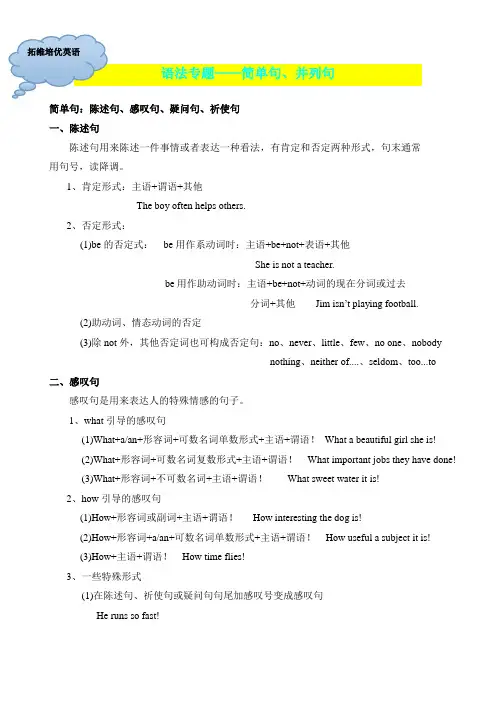
简单句:陈述句、感叹句、疑问句、祈使句一、陈述句陈述句用来陈述一件事情或者表达一种看法,有肯定和否定两种形式,句末通常用句号,读降调。
1、肯定形式:主语+谓语+其他The boy often helps others.2、否定形式:(1)be的否定式:be用作系动词时:主语+be+not+表语+其他She is not a teacher.be用作助动词时:主语+be+not+动词的现在分词或过去分词+其他Jim isn’t playing football.(2)助动词、情态动词的否定(3)除not外,其他否定词也可构成否定句:no、never、little、few、no one、nobodynothing、neither of....、seldom、too...to 二、感叹句感叹句是用来表达人的特殊情感的句子。
1、what引导的感叹句(1)What+a/an+形容词+可数名词单数形式+主语+谓语!What a beautiful girl she is!(2)What+形容词+可数名词复数形式+主语+谓语!What important jobs they have done!(3)What+形容词+不可数名词+主语+谓语!What sweet water it is!2、how引导的感叹句(1)How+形容词或副词+主语+谓语!How interesting the dog is!(2)How+形容词+a/an+可数名词单数形式+主语+谓语!How useful a subject it is!(3)How+主语+谓语!How time flies!3、一些特殊形式(1)在陈述句、祈使句或疑问句句尾加感叹号变成感叹句He runs so fast!(2)用一个词或词组表达强烈感情的句子Wonderful! Look out! Great!(3)以there、here等副词开头的感叹句There she is! There goes the bell!三、疑问句用以提问的句子较疑问句,句末用问号。

学校:________班级:________ 姓名:__________中考专题复习:简单句【复习目标】1.能辨别简单句句子成分;2.能识别简单句基本句型;3.能划分简单句种类,明确陈述句、疑问句、祈使句、感叹句考点在中考中的考查形式和规律,并运用其解决问题。
【预习导学】【考点讲解】一、简单句的定义简单句是由不同种类的单词或短语按照一定的语法规则组合在一起, 且只有一个主谓结构, 能表达一个完整意思的语言单位。
二、句子成分组成句子的各个部分即是句子成分。
句子成分主要有七种, 分别是主语、谓语、表语、宾语、定语、状语、补足语。
主语和谓语是句子的主体。
三、简单句的基本句型句子按照其结构可分为简单句、并列句和复合句。
其中简单句又可分为五大基本句型。
在英语中的各类复杂句子也都是由这五种基本句型扩展而成的。
(一)主语+谓语这种句型简称为主谓结构, 其谓语一般都是不及物动词。
The boy laughed at last. 最后这个男孩笑了。
主语谓语注意:(1)动词是不及物动词, 后面不能跟宾语, 也无被动语态。
(2)很多情况下, 不及物动词由副词或别的状语修饰, 有的动词如果不加状语修饰, 句意可能不完整。
She lived. →She lived in that country. 她住在那个国家。
(二)主语+谓语+宾语这种句型可称为主谓宾结构, 它的谓语一般多是及物动词或相当于及物动词的动词词组。
They will visit the Bird’s Nest this weekend.主语谓语宾语他们这个周末要去参观鸟巢。
注意:如果动词词组是“动词+副词”型, 而宾语又是代词时, 只能将宾语置于动词和副词之间; 若宾语是名词, 则在副词前后均可。
(三)主语+系动词+表语这种句型称为主系表结构, 连系动词在形式上也是一种谓语动词。
规律总结连系动词有三类:①表示状态的连系动词有: be, seem, stay, keep等; ②表示感官的连系动词有: look, sound, smell, feel, taste等; ③表示变化的连系动词有: get, go, become, turn, grow等。
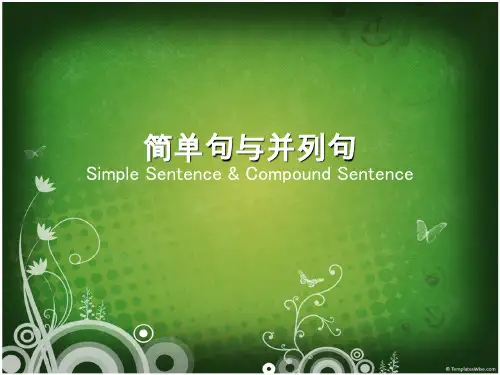
初中英语语法简单句基本句型总结一. 五种简单句基本句型1.“主语+ 谓语”(即“主谓”句型)这一句型英汉语言结构形式完全相同,说明“某人或某物如何动作”,或者说“某人或某物自身怎样运动”。
例:They arrived in Harbin yesterday morning.分析:“they”(主语)“arrived”(谓语)。
2.“主语+ 谓语+ 宾语”(即“主谓宾”句型)这一句型英汉语言的结构形式完全相同,用以说明“某人或某物做什么事情”,或者说“某人或某物发出了动作,并且其动作涉及到另一个人或物”。
例:I study English.分析:“I”(主语)“study”(谓语动作)“English”(宾语即动作涉及的对象)。
3.“主语+ 谓语+ 间接宾语+ 直接宾语”(即“主谓双宾”句型)这一句型英汉语序结构相同,说明“某人为谁(间接宾语为人)做某事”,或者说“某人或物的运动涉及到两个对象,其中一个间接对象为人,另一个为物”。
例:Our teacher taught us English.分析:“our teacher”(主语)“教”(谓语动作)“us”(间接宾语)“English”(直接宾语)。
4.“主语+ 谓语+ 宾语+ 宾语补足语”(即“主谓宾宾补”句型)这一句型说明“某人或某物要求(使、让)某人做什么”或“某人感觉某人或物怎么样”。
例:He asked her to go there.分析:“he”(主语)“asked”(谓语动作)“her”(宾语即动作涉及的对象)“to go there”(补语—补充说明宾语做什么)。
5.“主语+ 系动词+ 表语”(即“主系表”句型)这一句型用以说明“某人(某物、某事、某种概念)具有什么特征或处于什么状态”。
汉语的“是”字结构属于这一英语句型的形式之一。
常用的联系动词有be, keep,lie, remain, stand, become, fall, get, go, grow, turn, look, feel, seem, smell, sound, taste, 等。
初中英语简单句的基本句型讲解简单句:由一个主语(或并列主语)和一个谓语(或并列谓语)所构成的句子。
简单句分为5种基本句型:1.主语+谓语(主语+不及物动词)例1:My little sister can swim very well. 我妹妹游泳游得很好。
主语谓语(不及物动词)例2:The planehas already arrived. 飞机已经抵达。
主语谓语2.主语+谓语+宾语(主语+及物动词+宾语)例3:The poor passengers on the real Titanic saw the tip of the iceberg.主语谓语宾语泰坦尼克号上可怜的乘客们看到了冰山的顶部。
例4:The company makes films . 这家公司制作电影。
主语. 谓语宾语例5:Stanley bought a flat last year. Stanley去年买了套公寓。
主语谓语宾语3.主语+系动词+表语(主语+连系动词+表语)例6:My mother is a scientist. 我母亲是个科学家。
主语谓语表语例7:She looks young. 她看上去很年轻。
主语谓语表语例8:The cake tastes very yummy. 这蛋糕尝起来很美味。
主语谓语表语4.主语+谓语+双宾语(主语+及物动词+间接宾语+直接宾语)例9:My mother bought me a dictionary yesterday. 我母亲昨天给我买了本字典。
主语谓语间接宾语直接宾语例10:Can you give me the math book? 你能给我那本数学书吗?谓语主语谓语间接宾语直接宾语例11:Will you tell us something about your school life?谓语主语谓语间接宾语直接宾语你给我讲讲你们的学习生活,好吗?5.主语+谓语+复合宾语(主语+及物动词+宾语+补语)例12:We must keep our classroom clean and tidy. 我们必须保持教室干净、整洁。
中考英语语法知识讲解一、词性【实词】名词、代词、动词、形容词、副词、数词实词是指实在意义,能独立承担句子成分的词,实词有词形的变化。
【虚词】冠词、介词、连词、感叹词与实词相对,虚词没有实在意义,不能独立承担句子成分,虚词没有词形的变化。
1、名词(n.)表示人、事物、地点或抽象概念的名称。
[例]boy, morning, orange, clock, etc.2、代词(pron.)主要用来代替名词。
[例]who, she, you, it, etc.3、形容词(adj.)表示人或事物的性质或特征。
[例]good, white, orange, ugly, etc.4、数词(num.)表示数量或事物的顺序。
[例]one, two, three, hundred, etc.5、动词(v.)表示动作或状态。
[例]am, is, think, does, may, etc.6、副词(adv.)修饰动词、形容词、副词,说明时间、地点、程度等。
[例]now, often, slowly, home, hard, very, really, etc.7、冠词(art.)用在名词前,帮助说明名词。
[例]a, an, the.8、介词(prep.)表示它后面的名词或代词与其他句子成分的关系。
[例]in, on, at, from, above, under, behind, with, without, to, etc.9、连词(conj.)用来连接词、短语或句子。
[例]and, or, before, when, while, after, as soon as, if, unless, until, because, so, though, but, even if, even though, as if, etc.10、感叹词(interj.)表喜、怒、哀、乐等感情。
[例]oh, well, hi, hello, etc.二、句子成分1、主语句子所要说的人或事物,回答是“谁”或者“什么”。
初中英语句子专项复习一、简单句简单句是由一个主语和一个谓语构成的句子。
一般情况下,它们可以单独作为一个完整的句子存在。
例句:1. My brother is a doctor.我的兄弟是个医生。
2. They play basketball every afternoon.他们每个下午都打篮球。
二、并列句并列句是由两个或多个主句通过连词连接而组成的句子。
例句:1. I like playing soccer, and my sister likes swimming.我喜欢踢足球,而我妹妹喜欢游泳。
2. He is a good student, but he doesn't like studying.他是一个好学生,但他不喜欢研究。
三、复合句复合句是由一个主句和一个或多个从句组成的句子。
例句:1. We went to the park because the weather was nice.我们去了公园因为天气很好。
2. Jack is going to the party, which starts at 8 o'clock.杰克要去参加晚会,那个晚会八点开始。
四、疑问句疑问句用来询问问题,通常以疑问词或助动词开头。
例句:1. Who is your best friend?你最好的朋友是谁?2. Have you finished your homework?你完成作业了吗?五、祈使句祈使句用来表达请求、命令、建议或劝告,一般省略主语。
例句:1. Open the window, please.请打开窗户。
2. Don't forget to bring your umbrella.别忘记带上你的雨伞。
以上是初中英语句子专项复的内容,希望对你有帮助!。